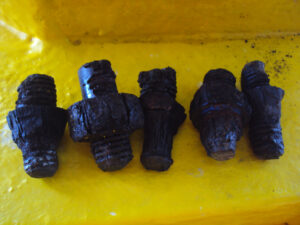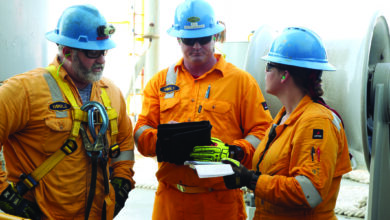How to safely, efficiently use hot bolting to combat corrosion
Detailed planning, use of hot bolt clamp can minimize risks with single stud replacements
By Thomas Lamb, Hydratight
Corrosion is a worldwide problem that has been estimated to cost around 3% of global GDP, or approximately $2.5 trillion, according to a 2016 NACE study. Steel corrodes through an electrochemical process – hydrogen and oxygen combine with iron during contact with water and air. This creates the hydrated iron oxide that colors aging steel and is commonly known as rust.
Rust is the red iron oxide that is the most common by-product of corrosion. It is a major challenge, particularly in coastal sites and offshore installations where high levels of salt will introduce chloride into the equation. Chloride speeds up the corrosion process.

The effect of rust is well known. Microscopic pits are created, which slowly eat away at the parent metal, reducing the material strength and wasting it away until it disintegrates. The only way to get assurance on the material strength of a corroded item, such as a nut or bolt, is to completely clean off the corrosion product and compare the dimensions with the original specification.
The reduction in material strength created by corrosion is particularly concerning when it comes to the fasteners within a bolted flanged joint. There are millions of flanged joints around the planet, piping crucial raw and finished products to wherever they’re needed. These critical pieces of infrastructure are all held together with the humble bolt.
When corrosion affects bolts, it can reduce the material strength to the point of failure. In the instance of a bolted flanged joint that is holding critical hydrocarbons on an oil or gas facility, this poses one of the greatest threats to flange joint integrity with potentially catastrophic consequences to the site and the environment – particularly when the rig is an offshore location. Related phenomena have also been discovered, such as galvanic corrosion, where stainless steel and carbon steel are in contact with a suitable conductor (water) causing the carbon steel to corrode at a faster rate.
Another example is corrosion under insulation, where the insulation creates a “micro-climate,” again increasing the rate of corrosion. This goes undetected due to the insulation “hiding” the problem. With the age of assets within this industry starting to exceed their original design lifetime, corrosion will feel like a constant, losing battle to some asset owners.
The statistics back this up, with a recent report showing more than $300 million was lost between 2016 to 2019 in North American refineries built in 1960 or earlier. The report also cites an increase in failures after 20 to 30 years in operation. Addressing this problem can come with an enormous cost.
A robust risk-based inspection system is required to identify both the problem and the source of the problem, such as water pooling around a bolted joint. But this will still leave a huge headache when it comes to rectifying the defects. With the high threat that corroded fasteners pose within important pressure boundary bolted flange joints, a resolution must be found.

A safe and efficient solution to corroded fasteners
Fortunately, single stud replacement and the hot bolt clamp can help to address issues with corroded fasteners. ASME PCC-2 defines single stud replacement as “the sequential removal and replacement of bolts on flanged joints while under reduced operating pressure,” with a key element of that definition regarding the operating pressure. This is because single stud replacement is a potentially dangerous practice that requires removing seized or corroded fasteners from live flanged joints, where the consequences of leakage can be catastrophic.

Single stud replacement, or hot bolting, has historically been used for pre-shutdown activities and includes removing, cleaning, lubricating and reinstalling existing bolts, thus making maintenance timelines more predictable and increasing efficiency during major outages. More recently, this process has been identified as a solution to corroded or defective fasteners, as these components will have the greatest effect on plant integrity. A planned single stud replacement campaign is safer and cheaper than the cost of repairing the damage created by fastener failure. The reduction in rig downtime will also reap huge rewards (Table 1), whether by addressing a defect during live operations or making a planned maintenance outage more efficient.
However, these rewards come with greater risks as single stud replacement is potentially hazardous, and extreme caution is required in its planning and execution. It may expose the rig to hazards with obvious ecological and safety risks, such as the release of contained mediums under pressure or at temperature, hydrocarbon or toxic substances, stored energy, etc.
EEMUA Information Sheet 17 states: “The practice of removing and replacing or freeing and re-tightening bolts on live piping and equipment is potentially hazardous, and the utmost caution therefore needs to be exercised when planning and carrying out these operations.”
It goes on to say: “Working on live piping and equipment should normally only be contemplated when the advantages have been assessed against the risk. Marginal time savings during shutdowns on flange disassembly (breaking) operations should not be considered sufficient incentive for using the technique.”
ASME PCC-2 also stipulates: “Although hot bolting and half bolting removal procedures can reduce plant downtime, they are potentially hazardous and therefore caution shall be exercised in their planning and execution.”
To offer assurances during the single stud replacement process, a hot bolting clamp should be utilized. It is mandatory as per best practice when attempting to hot bolt four-bolt flanges to increase the safety of the operation and decrease the chances of a leak. While stop-gap solutions, such as welders G clamps, have historically been utilized, it is important to ensure any hot bolting device utilized is designed and suitable for the purpose and not giving a false sense of security.
It is also important that any hot bolting device can control the bolt load it imparts on the bolted flange joint as over- or underloading the application can have further detrimental effects or damage the gasket. Therefore, it is vital for type approval or similar and detailed service records to prove a solution will solve this problem, rather than creating a potentially dangerous situation.
A hot bolting procedure case study
Hot bolting clamps and single stud replacements have been safely utilized around the world to counter the dangers of corrosion by changing thousands of corroded fasteners. One such project was completed recently on a floating production storage and offloading (FPSO) vessel, where single stud replacement was utilized on 61 four-bolt flanges. It safely changed out 244 corroded bolts and upgraded the integrity of the site. FPSOs combine the maintenance demands of both a vessel and a plant. Thus, it is imperative that a strict schedule is followed to ensure the integrity of the asset.
For any hazardous operations such as single stud replacement, thorough planning is essential. A detailed assessment of the individual joint with respect to joint material conditions, area specific risks, contingency plans, access and egress, local hazards, leak monitoring, communications and more is required, as was the case in the scope of this project. The assessment will allow hazardous conditions to be identified in advance of the operation. From there, protocol can be implemented, including contingency plans for the worst-case scenario, i.e. a leak occurs during operation.
One of the key elements to remember is that pressure will increase the likelihood of a leak and the pressure should always be as low as reasonably possible. Best practice limits operating pressure to 50% of design pressure (qualified by assessment) and requires at least eight bolts in the flange (albeit also identifying eight bolt 150# flanges as being underbolted).
Most flanges, especially in the higher-pressure classes, theoretically have sufficient safety factor within bolt load across the flange to allow for a safe hot bolting operation within the given limits. The reason is that, for any flange, removing a single stud has the potential of reducing the clamping load on the gasket contact surface. With a four-bolt flange, the removal of a fastener effectively leaves a large portion of the gasket contact surface under-supported, increasing the likelihood of a leak and dictating the requirement for a hot bolt clamp for these operations.
This project shows that using skilled contractors with specialized equipment is the safest way to utilize single stud replacement and to realize the rewards to joint integrity that this service can offer. In this case, 61 four-bolt flanges had their fasteners renewed with no impact to operations, as opposed to a maintenance campaign during an outage. The latter would have cost millions of dollars in lost production, as well as the cost of isolations, flushing/purging, actual maintenance and, of course, the requirement for specialized machining equipment/contractors to repair potential flange face damage.
Conclusion
It is important to remember that when contemplating single stud replacement, the risk versus reward must always be considered. When analyzing the associated risks, consequences and likelihood are the foundation of a thorough application assessment. Consequences are almost always high when working with live pipework. The likelihood is the balance between the joint’s condition, operating parameters and the skills of the personnel who assembled and tightened the joint originally and the personnel who will perform the live bolting operation.
While the risks of working on live pipework will always be present, the savings in lost production will likely allow the practice of single stud replacement with the hot bolting clamp to gain traction around the world to combat the threat of corrosion. Provided skilled engineers are involved in planning and execution, these techniques can be completed safely and without impact to the asset or the environment. DC
References:
NACE, International Measures of Prevention, Application and Economics of Corrosion Technologies Study, 2016
Marsh JLT Specialty, 100 Largest Losses in the Hydrocarbon Industry, 1974-2019, 2020
ASME PCC-2, Repair of Pressure Equipment and Piping, 2018
EEMUA Information Sheet 17, Guidance Procedure for the Removal and Replacement of Flange Joint Bolting on Live Piping and Equipment, 2005



